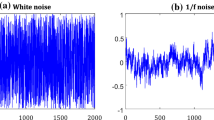Abstract
The human heartbeat interval is determined by complex nerve control and environmental inputs. As a result, the heartbeat interval for a human is a complex time series, as shown by previous studies. Most of the analysis algorithms proposed for characterizing the profile of heartbeat time series, such as detrended fluctuation analysis and multi-scale entropy, are based on various characteristics of dynamics. In this study, we present an empirical mode decomposition-based intrinsic mode analysis, which uses the appearance energy index (AEI) to quantify the property of long-term correlation, and structure index (SI) to characterize the internal modulation of data. This presented algorithm was used to investigate the human heartbeat time series downloaded from PhysioBank. We found the profiles of human heartbeat time series of subjects with congestive heart failure (CHF) or atrial fibrillation (AF) are significantly different from those of healthy subjects in internal modulation as shown by SI. Moreover, AEI is the critical characteristics for verifying subjects with CHF from subjects with AF in a degree of long-term correlation. Both AEI and SI contribute to presenting the characteristic profiles of a human heartbeat time series.




Similar content being viewed by others
References
Berntson, G. G., J. T. Carcioppo, and K. S. Quigley. Cardiac psychophysiology and autonomic pace in humans: empirical perspectives and conceptual implications. Psychol. Bull. 114(2):296–322, 1993.
Costa, M., A. L. Goldberger, and C.-K. Peng. Multiscale entropy analysis of complex physiologic time series. Phys. Rev. Lett. 89(6):068102, 2002.
Craft, N., and J. B. Schwartz. Effects of age on intrinsic heart rate, heart rate variability, and AV conduction in healthy humans. Am. J. Physiol. 268:H1441–H1452, 1995.
Databases are available at http://www.physionet.org/. See A. L. Goldberger et al., Circulation 101:E215, 2000.
Echeverria, J. C., J. A. Crowe, M. S. Woolfson, and B. R. Hayes-Gill. Application of empirical mode decomposition to heart rate variability analysis. Med. Biol. Eng. Comput. 39:471–479, 2001.
Flandrin, P., and P. Goncalves. Empirical mode decomposition as a data-driven wavelet-like expansions. Int. J. Wavelet, Multires. Info. Proc. 2(4):1–20, 2004.
Flandrin, P., P. Goncalves, and G. Rilling. EMD equivalent filter bank, from interpretation to applications. In: Hilbert–Huang Transform: Introduction and Applications, edited by N. E. Huang and S. S. P. Shen. Singapore: World Scientific, 2005, pp. 57–74.
Flandrin, P., G. Rilling, and P. Goncalces. Empirical mode decomposition as a filter bank. IEEE Signal Process. Lett. 11:112–114, 2004.
Goldberger, A. L., C.-K. Peng, and L. A. Lipsitz. What is physiologic complexity and how does it change with aging and disease? Neurobiol. Aging 23:23–26, 2002.
Huang, N. E., Z. Shen, S. R. Long, M. C. Wu, H. H. Shih, Q. Zheng, N.-C. Yen, C. C. Tung, and H. H. Liu. The empirical mode decomposition and the Hilbert spectrum for nonlinear and non-stationary time series analysis. Proc. R. Soc. Lond. A 454:903–995, 1998.
Hurst, H. E. Long-term storage capacity of reservoirs. Trans. Am. Soc. Civ. Eng. 116:770, 1951.
Lasko, T. A., J. G. Bhagwat, K. H. Zou, and O. M. Lucila. The use of receiver operating characteristic curves in biomedical informatics. J. Biomed. Inform. 38:404–415, 2005.
Mandelbrot, B. B., and J. W. van Ness. Fractional Brownian motions, fractal noises and applications. SIAM Rev. 10:422–437, 1968.
Peng, C. K., S. Havlin, H. E. Stanley, and A. L. Goldberger. Quantification of scaling exponents and crossover phenomena in nonstationary heartbeat time series. Chaos 5:82–87, 1995.
Peng, C. K., J. Mietus, J. M. Maudorff, S. Havlin, H. E. Stanley, and A. L. Goldberger. Long-range anticorrelations and non-Gaussian behavior of the heartbeat. Phys. Rev. Lett. 70:1343–1346, 1993.
Pincus, S. M. Assessing serial irregularity and its implications for health. Ann. N. Y. Acad. Sci. 954:245–267, 2006.
Porta, A., S. Guzzetti, N. Montano, R. Furlan, M. Pagani, A. Malliani, and S. Cerutti. Entropy, entropy rate, and pattern classification as tools to typify complexity in short heart period variability series. IEEE Trans. Biomed. Eng. 48:1282–1291, 2001.
Richman, J. S., and J. R. Moorman. Physiological time-series analysis using approximate entropy and sample entropy. Am. J. Physiol. 278:H2039–H2049, 2000.
Task Force European Society of Cardiology and North American Society of Pacing Electrophysiology. Heart rate variability. Standards of measurement, physiological interpretation, and clinical use. Eur. Heart J. 17:354–381, 1996.
Wood, A. T., and G. Chan. Simulation of stationary processes in [0, 1]d. J. Comput. Graph. Stat. 3:409–432, 1994.
Wu, Z. H., and N. E. Huang. A study of the characteristics of white noise using the empirical mode decomposition method. Proc. R. Soc. Lond. A 460:1597–1611, 2004.
Yang, A. C. C., S. S. Hseu, H. W. Yien, A. L. Goldberger, and C. K. Peng. Linguistic analysis of the human heartbeat using frequency and rank order statistics. Phys. Rev. Lett. 90(10):108103, 2003.
Acknowledgments
The authors wish to thank Prof. Ary L. Goldberger and Dr. C. K. Peng (the director and co-director of the Rey Institute for Nonlinear Dynamics in Medicine at the Beth Israel Deaconess Medical Center of Harvard Medical School) for valuable discussions. We gratefully acknowledge the support from National Science Council (NSC) of Taiwan (Grant number NSC96-2221-E-155-015-MY3-2) for this research.
Author information
Authors and Affiliations
Corresponding author
Additional information
Associate Editor Berj L. Bardakjian oversaw the review of this article.
Rights and permissions
About this article
Cite this article
Yeh, JR., Sun, WZ., Shieh, JS. et al. Intrinsic Mode Analysis of Human Heartbeat Time Series. Ann Biomed Eng 38, 1337–1344 (2010). https://doi.org/10.1007/s10439-010-9939-z
Received:
Accepted:
Published:
Issue Date:
DOI: https://doi.org/10.1007/s10439-010-9939-z




